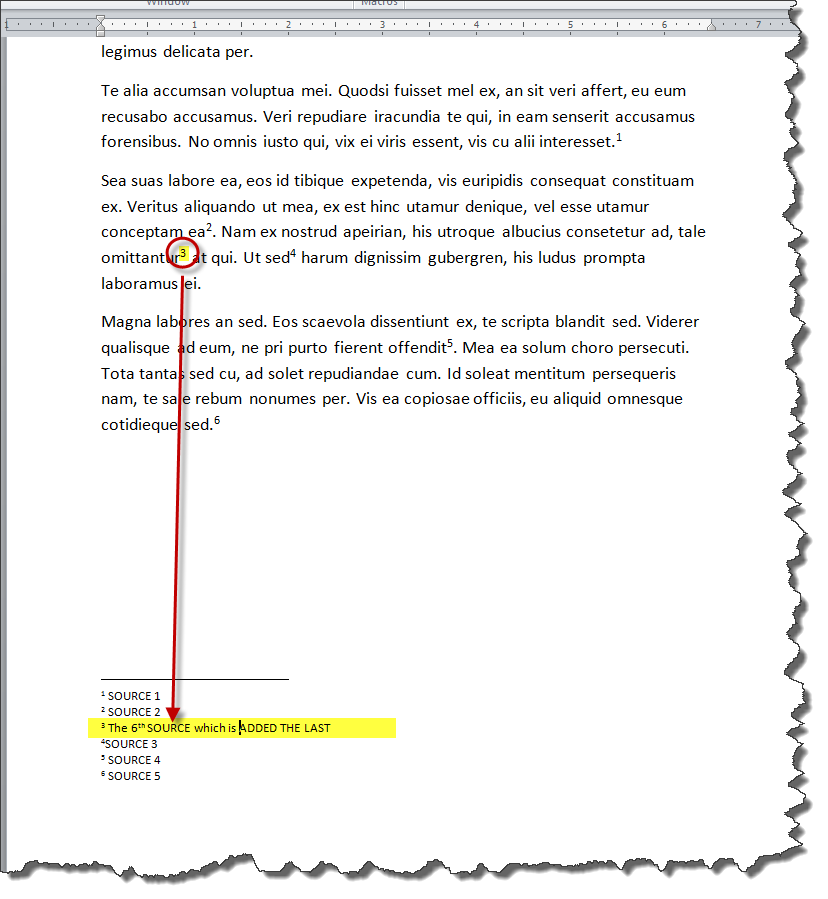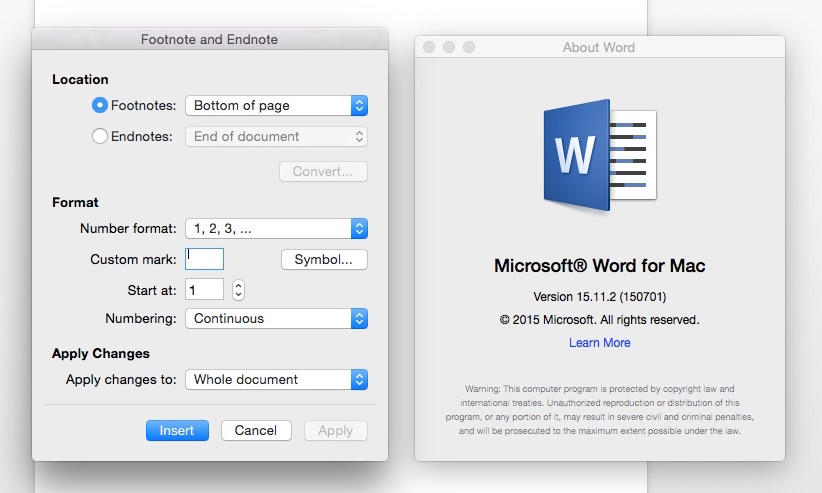- Columns In Microsoft Word 2007
- How To Make A Footnote Two Columns In Microsoft Word For Mac Download
- How To Make A Footnote Two Columns In Microsoft Word For Mac Computers
Roger was sent a Word document that he needed to edit. The document had 90 footnotes in it, and he needed to delete footnote 23. Roger went into the document body, found the footnote marker for the appropriate footnote, and then deleted it. The footnote was actually deleted, but the remaining footnotes did not renumber. Roger wonders what could be causing this problem with the footnotes.
In the Cross-reference dialog select Footnote as the Reference type and Footnote number (formatted) in the Insert reference to dropdown. Select the actual footnote reference mark (in the single-column text) and format it as Hidden (Ctrl+Shift+H). The false footnote reference as seen with nonprinting characters displayed. Place your cursor within the document where you want the reference number for the footnote or endnote. This is usually at the beginning of a word or phrase. Click on the References tab. Select Insert Note to the foot or Insert note at the foot according to your preferences.
The answer could be quite simple, and related to using the Track Changes feature of Word. When many people edit documents, they do so with Track Changes turned on. In that case, deleting the footnote doesn't actually delete it, but simply marks it as deleted text. Word doesn't renumber the footnotes because the footnote is still there—albeit marked for deletion. When the changes are accepted or rejected, then Word will renumber the footnotes accordingly.
If you are doing your edits without Track Changes being turned on, then it is possible that your footnotes don't use automatic numbering. Meaning, whoever created the footnotes actually inserted the numbers within the Custom Mark field of the Footnote and Endnote dialog box. Display the dialog box again and you can figure out if this is the case.
It is also possible that the document has multiple sections in it and that each section (or at least the section containing footnote 24) has been configured so that footnotes for that section begin with a specific number. You can figure this out by putting the insertion point in the section containing footnote 24, displaying the Footnote and Endnote dialog box, clicking Options and examining how the numbering is configured in that dialog box.
Columns In Microsoft Word 2007

Finally, if you've tried everything else and the numbering is still messed up, try to 'force' Word to examine the numbers it is using. Do this by following these steps:

- Press Ctrl+H to display the Replace tab of the Find and Replace dialog box.
- Click the More button, if it is available.
- Click the Use Wildcards radio button.
- With the insertion point in the Find What box, click Format and choose Style. Word displays the Find Style dialog box.
- Locate and click on the Footnote Reference style.
- Click OK to close the Find Style dialog box.
- In the Replace With box enter the following: ^&
- Click Replace All.
The purpose of these steps is to try to remove any confusion that Word may be experiencing and cause it to renumber all the footnotes. If this approach doesn't work, try just a bit of a different approach:
- Press Ctrl+H to display the Replace tab of the Find and Replace dialog box.
- Click the More button, if it is available.
- Make sure the Use Wildcards radio button is cleared.
- With the insertion point in the Find What box, click No Formatting and enter the following: ^f
- In the Replace With box enter the following: ^&
- Click Replace All.

Word includes the ability to place footnotes at the bottom of each page in your document. By default, the footnotes are placed into the same number of columns as you are using in the document. Thus, if your document uses two columns, then the footnotes will be placed into two columns, as well. In general, each of the footnotes appears under the same column in which the footnote reference appears.
Word 2013 added the ability to have your footnotes appear using a different number of columns than the main body of your text. (This is a huge formatting boon for those using footnotes.) Insert your footnotes as normal, but then follow these steps:
- Display the References tab of the ribbon.
- Click the small icon at the bottom-right of the Footnotes group. Word displays the Footnote and Endnote dialog box. (See Figure 1.)
- Make sure that the Footnotes radio button is selected.
- Use the Columns drop-down list to indicate how many columns you want Word to use to display the footnotes.
- Click OK.
Figure 1. The Footnote and Endnote dialog box.
How To Make A Footnote Two Columns In Microsoft Word For Mac Download
At this point Word reformats any existing footnotes so that they match whatever number of columns you specified in step 4. You don't have any control over the width of the individual columns; Word makes them all of equal width.

If you are using an older version of Word and you want your footnotes to appear in a different number of columns than your document does (for instance, two columns of footnotes when the body is a single column), you are out of luck; Word can't handle it. You could work around the problem by 'faking' the footnotes, meaning to enter them manually (as regular text) and placing the notes themselves in a multi-column table placed at the bottom of the page. Of course, your footnotes won't automatically renumber, and they won't flow from page to page as you add or remove text from the body of the document.
How To Make A Footnote Two Columns In Microsoft Word For Mac Computers
If your desire is to have your footnotes in a single column while your text body is in multiple columns, the folks at the Word MVP site have come up with a workaround. You can find it here: